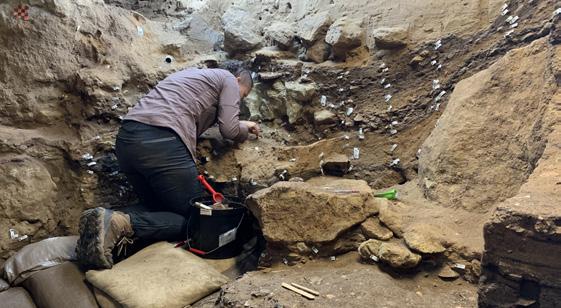ACTIVITIES IN 2020 20
SYMBOLS IN MIND AND BODY What were visual symbols used for by Middle Stone Age (MSA) humans, and how? Why did communication through material symbols arise in the first place? Can their current uses inform us about their origin and evolution? How are they perceived and processed in the brain? These are all questions that researchers of the SapienCE subgroup Symbolic Mind, Cognition, and Social Organization are addressing in various ongoing studies. The results of these projects will widen our understanding of the emergence of characteristic aspects of the modern human mind and behaviour, such as aesthetic and symbolic cognition.
Whereas archaeological material such as lithics and faunal remains can inform us about past subsistence strategies, diet, and technology, so-called symbolic artefacts can tell us about the ways in which people viewed and interacted with their world.
THE ROLE OF SYMBOLIC COMMUNICATION IN THE MSA The postdoctoral research of Larissa Mendoza Straffon looks at the role that symbolic communication technologies, like ochre, personal ornaments, and visual signs may have played in the social lives of modern humans living in the Western Cape coast during the MSA. One possibility being explored is that these practices emerged within the context of cooperative relations, at a time when hunter-gatherer bands were establishing increasingly complex exchange networks. Testing this proposal requires a meticulous review of archaeological data, climate research, and cognitive anthropology, and hence synthesizes data from across all SapienCE research groups. Information from each group theme can help identify possible occupation and material exchange patterns that point to the existence of social networks within which group relations may have been mediated by symbolic communication. The focus is on artefacts from the Still Bay layers at Blombos Cave, which include early examples of geometric engravings, ochre pigment production, shell beads, and stylized lithics. Ascribing a social context and function for MSA symbolic technologies, beyond their aesthetic aspect, can help us integrate the archaeological evidence from this period and region with our understanding of modern human cognition and its capacity for problem solving in the past and in the present.
DISENTANGLING THE ONTOGENY OF DRAWING As part of the Visual Signs as Cognitive Tools: Phylogeny
and Ontogeny project, funded by the John Templeton Foundation and in collaboration with Leiden University, Larissa Mendoza Straffon is carrying out a study on the ontogeny of drawing. Working with psychology students, the team plans to gather data related to the development of children’s minimal skills required to identify complex visual stimuli, on the one hand, and to produce hierarchically organized patterns and designs, on the other. Visual signs, together with language and gestures, constitute the basic forms of human symbolic communication. Throughout children’s early development, these symbolic systems organize cognition and drive learning processes. They act as a cognitive tool or means of mental problemsolving that helps us to think, to communicate, to remember, to judge, and to make decisions. Despite much research into the ontogeny of pictorial representation, the underlying cognitive and behavioural mechanisms of drawing remain relatively unknown. This study aims at disentangling some of the core perceptual, cognitive, and social processes that lay the foundation for visual marking and, eventually, visual artistic behaviour. For example, the basic motor/cognitive capacities that allow for mark-making at an early stage, such as the average age at which children can manipulate tools, or direct and sustain attention, and whether or to what extent these are affected by socialization and cultural scaffolding. Subjects will include children ages 2-7. The lower range is the age at which children have been reported to start understanding symbolic visual signs, whereas the upper range includes the age at which they fully use symbolism across different domains. The results are expected to contribute towards theoretical debates regarding the developmental sequence of symbolic cognition (e.g, Piagetian vs. Vygotskian models) and its potential adaptive benefits in human evolution.





















